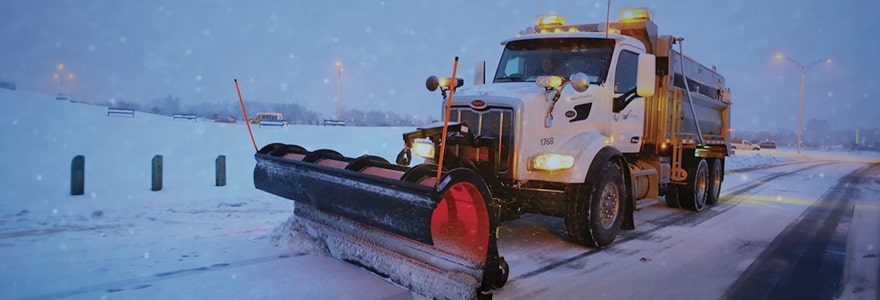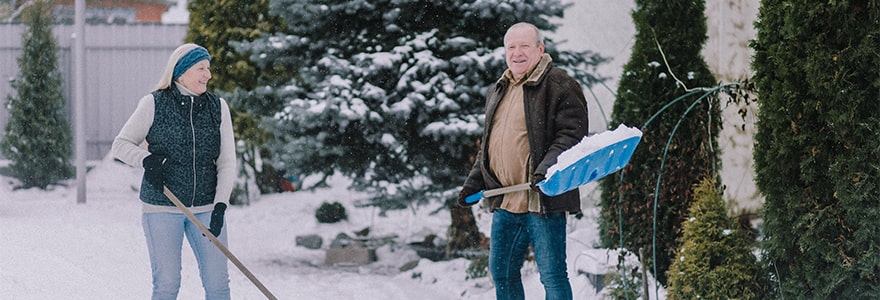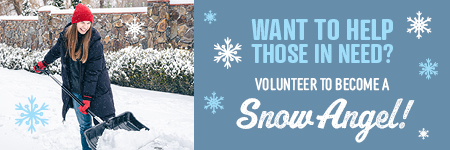Resident Guide to Winter Weather

Get Ready for Winter
From ensuring your vehicle is equipped with snow tires to stocking eco de-icer to securing loose objects on your property, you can take steps to make winter weather easier on you.
How to Prepare Your Vehicle
- Install good winter tires on your vehicle.
- Keep your gas tank full.
- Check that all lights and defrosters are in good working condition. If it's snowing, turn on your headlights and taillights.
- Replace windshield wipers with ones especially designed for icy weather.
- Top up your vehicle’s reservoir with winter window wash fluid.
- Check your battery—a vehicle with a weak battery won’t start in cold temperatures.
- Throw a windshield scraper and brush in your car, as well as a bag of sand, flares, emergency blanket and kit, warm clothes and waterproof boots. Small shovels are also handy. Wear bright or reflective clothing if you must exit your car.
- Reduce speed in snowy or slippery conditions. Leave extra distance between you and the car ahead of you.
- Leave 50 metres distance between your vehicle and any City snow clearing equipment such as plows or salt trucks. The operator's visibility can be limited.
- Leave earlier—adjust your schedule to allow more travel time, particularly during commutes. Check traffic and weather reports before heading out.
- Check your route and our Snow Removal Route Map to take advantage of the first priority snow clearing.
Visit Drive BC and Ministry of Transportation for more information.
How to Prepare Your Property
- Do you have a good snow shovel by your door? They sell out fast during snow days and Traffic Bylaw 5870 requires residential (single-family and multi-family) owners and occupants, as well as commercial and industrial properties, to remove snow and ice no later than 10:00am daily.
- Shovel snow onto your lawn or a designated parking stall, not the street. Shoveling snow onto the street is a hazard for vehicles and creates more work for snow plows, slowing down the clearing process - it also increases the chance that snow will be pushed back onto your driveway or sidewalk.
- Locate and clean catch basins or storm drains in the roadway in front of your home of debris such as fallen leaves, branches and snow for proper drainage. Take care not to bury these grates or gutters when shoveling snow.
- Clear leaves from your roof’s eaves and ensure appropriate drainage near your house to prevent puddling.
- Secure everything that might be blown around or torn loose - flying objects such as garbage cans and lawn furniture can injure people and damage property.
- Trim dead branches and cut down dead trees to reduce the danger of these falling onto your house during a storm.
- Store a de-icer product and spread it on your walkways after ice forms to give traction; organic and ecologically safe de-icers won’t corrode concrete and are safer for vegetation, pets and children.
- Do not use salt or de-icers on new concrete. If salt or de-icers are left to sit on new concrete (poured within one year), they cause repetitive freeze-thaw cycles that lead to surface spalling (water crystallizing in pores). Follow manufacturer's instructions; which typically advise to use sand instead. Have a snow shovel on hand.
- If you have a fire-hydrant in front of your home, please clear the snow around it for easy emergency access.
- If possible, park your vehicle in your driveway and garage to free up street space for plows.
- Consider alternative safe heating sources in the event of a power outage or heating system failure. Make sure your home is properly insulated and ensure cold air is kept out.
- If you experience a power outage, check the BC Hydro outage map/list to see if they already know about it. If your outage isn't listed, call 1-800-BCHYDRO (1-800-224-9276) to report the outage.
- Downed power lines should be considered energized and dangerous -- please stay away (at least 10 metres) and call 911.
- If your home loses power, unplug sensitive electronic equipment to protect them from possible voltage surges/irregularities when power is restored. Do not use outdoor barbeques or heating devices indoors. If you have an emergency gasoline-powered generator, keep it far away from doors and windows to prevent carbon monoxide from entering your home.
- Know how to shut off water valves and be aware of pipes that may freeze.
- Talk to your neighbours about all parking on one side of the road. Keeping one side of the curb free allows for better snow plow access. It also helps avoid possible snow pile-up on your car from the snow plow.
- Keep heating appliance air intakes or exhaust ports clear of snow and ice.
- Keep space heaters at least three feet away from any combustible materials, do not use with extension cords, and do not leave heaters or candles unattended or with unsupervised children or pets.
- Keep curbs free from debris and bins. Remove any decorations, garbage, recycling and organic bins off roadways where snow plowing may take place. Check the collection schedule for notices about delayed collection.
How to Prepare Yourself
- Hire a student or use a volunteer service (e.g. Snow Angels) if you have physical or health limitations to shovel your walkway and drive. Lend a hand to those who may need assistance if you are able.
- Have an emergency kit on-hand that includes a flashlight with batteries, glow-in-the-dark stick lights, wind-up clock, portable radio, manual can opener and Mylar blanket.
- Stock drinking water (one gallon per person per day), dry and canned food and first aid materials.
- Stock up on additional blankets, in case of prolonged power outages.
- Know how to manually override your electric garage door.
- If you live in a secured building, know which exit door to use during an outage.
- Follow a reputable weather source and be aware of potential weather changes expected throughout the day before you leave the house.
- Be smart and dress appropriately–hat, gloves and warm, waterproof footwear are necessary for all outdoor activity.
- Develop an emergency plan with your family to identify where each member should go if getting home is not possible because of weather conditions.
- Familiarize yourself with school, daycare and employer snow policies.
- Buy groceries/medications/important supplies before conditions worsen or a storm hits.
- Make sure pets have access to a warm shelter and are not left outside or in a cold car.
- Always be aware of the weather forecast, especially when driving. Make sure you feel confident to drive, use a more suitable car with winter tires if possible or have a friend or family member drive.
- Keep updated with transit routes and schedules and check Translink's website for updates on delays or service interruptions.
- Visit www.richmond.ca/emergency for emergency kit checklists and additional preparedness tools or plans.

During a Snow Storm
- Shovel early and often—new snow is lighter than packed or partially melted snow.
- Please, do not shovel snow onto sidewalks or the roadway—this is a hazard to pedestrians and to vehicles.
- To avoid clearing your driveway twice, pile snow on the left side (facing your house). This can minimize the amount of snow pushed back into your driveway by snowplows.
- Avoid parking on the road if a storm is forecast or after a storm. Parked cars on the designated routes can impede the ability of snowplow drivers to do their job. As well, parked cars on narrow streets combined with accumulated snow and icy conditions are a potential hazard and leave less room for travelling vehicles to maneuver.
- Avoid driving and other travel until conditions have improved. Keep roads clear for those who have to be on them.
- If you must travel, use transit whenever possible. Richmond’s bus routes are the first priority for snow clearing and major bus stops will be cleared by City crews as a second priority.
- Follow a trusted news source for weather and traffic conditions and leave the house prepared. For still images of current traffic conditions, check out the City's Intersection Cameras.
- Before you start driving, remove all accumulated snow from your vehicle's windows and lights; remove snow from your car hood and roof to prevent it from blowing onto your windshield or from affecting other motorists while you drive.
- For your safety, stay back a minimum of 15-metres from a snow plow.
- Clear the snow from any fire hydrants in front of your home in case of an emergency.
- To help crews collect your garbage and recycling, you can assist by clearing a small path which will allow collectors to wheel the carts more easily to the collection truck. This will improve safety for our crews in avoiding them having to lift heavy carts over snow drifts as well as help make the collection process as quick as possible to avoid collection service delays to other residents.
After a Snow Storm
- Before 10:00am daily, clear snow from around the catch basins and along the gutter adjacent to your home to accelerate snow melt and reduce the risk of flooding.
Shovel Your Sidewalks New!
Richmond home owners and occupants play a vital role in keeping sidewalks safe for pedestrians during the winter.
Home owners and occupants are responsible for clearing snow and ice from the front, and if on a corner lot, along the side(s) of their property by 10:00am, 7 days a week.*
$70 fine for not shovelingOwners and occupants who fail to remove snow and ice are subject to a $70.00 fine. (Bylaw 5870, section 6.1.)
Tips for shovelling:
- Shovel snow onto your property, not onto the road and sidewalks.
- Clear storm drains of leaves and snow to prevent localized flooding.
- Ask someone to clear your sidewalk if you are away or need help.
Shovel Your Sidewalks Poster
Be a Good Neighbour
Be a Good Neighbour This Winter Poster
Snow Angels

Snow Angels voluntarily help shovel sidewalks and walkways for community members who are elderly, ill or have mobility concerns, and who are negatively affected by a heavy snowfall. Choose your preferred geographic area and the number of residences you would like shovel. Training, shovel, toque and ice melt provided!
Volunteer to Become a Snow Angel!
Looking to make a difference in Richmond this winter season? Then register to be a Richmond Snow Angel at icanhelp.richmond.ca or contact the Snow Angel Coordinator at 604-247-4947. Individuals, families and businesses are encouraged to volunteer!Need a Snow Angel?
Need help removing snow from your walkway and sidewalk this winter? Apply for your very own Richmond Snow Angel!
Richmond’s Snow Angels provide help to residents who are elderly, ill or have mobility concerns, and who are negatively affected by a heavy snowfall (minimum 3 centimetres of snow).
How to Apply for a Snow Angel
Contact the Snow Angel Coordinator at 604-247-4453 or parksprograms@richmond.ca.Deadline: Friday, December 9 (applications received after the deadline will be added to a waitlist)
Note: While every effort is made to help all those in need, the program is dependent on the severity of the storm and the number of volunteers available.
Pick-Up and Delivery of Groceries and Medication
Note: Snow Angels do not pick-up or deliver medication or groceries. However most of the larger pharmacies and grocery stores do provide this service. Contact your nearest pharmacy of grocery store for assistance.Snow Angels Publications
Snow Angels FAQHeavy Rains
Materials for sandbags will be available at the Public Works Yard, 5599 Lynas Lane, as of October 27, 2022. Contact the Public Works Dispatch Line at 604-270-8721 for more information.
Visibility is poor in rainy conditions, particularly at night. If you must drive during stormy conditions: be alert, watch for all other road users and be prepared to stop. Drive according to the conditions: slow down, turn headlights and taillights on, leave generous following/stopping distance between other vehicles and give yourself extra travel time to arrive at your destination. Be bright, use light and wear reflectors if you are on foot or bike.
Flooding
During times of high water levels or storm surges, stay clear of fast flowing rivers and waterways, shorelines and possible unstable riverbanks.
- River levels may rise quickly and flows may be stronger
- Unexpected waves can occur. Keep an eye on pets and children
- Be aware of potential increase in logs or floating debris
For emergencies, due to water/flooding, call 911
For minor water accumulation, call the 24-hour City of Richmond Public Works Dispatch Line at 604-270-8721
- Flood Warning: River levels have exceeded capacity or will exceed it imminently, and that flooding of area adjacent to affected rivers will result.
- Flood Watch: River levels are rising and will approach or may exceed capacity. Flooding of areas adjacent to affected rivers may occur.
- High Streamflow Advisory: River levels are rising or expected to rise rapidly, but no major flooding is expected. Minor flooding in low-lying areas is possible.
- Freshet: Term used to describe spring flooding due to snowmelt and rainfall.
Visit Emergency Preparedness for more information on flooding preparations.
Wind Storms or High Winds
In preparation for high winds, secure items that may blow away.
Wind warnings are issued for most BC coastal regions when sustained winds of 65 km/h or greater, or gusts of 90 km/h or greater are expected.
During periods of high winds, and in particular during power outages, please stay off the roads. If you must travel, give yourself extra time since street lamps and traffic signals may not be working.
Remember your traffic safety rules: an intersection normally controlled by signal lights during a power outage becomes a four-way stop. Always stop at a darkened intersection and proceed with caution.
Please be cautious during and after wind storms as tree debris or loose objects may be tossed by the wind and cause injury or damage. Take care if outside and avoided treed areas. To report fallen trees on City of Richmond property (streets, parks, etc.), call Public Works at 604-244-1262.

